Best LinkedIn Ads Strategies Compilation
Facebook and Instagram still work—but reach is shrinking fast. LinkedIn’s the outlier, and if you’re in B2B, it’s where you need to be.
The networking site is seeing record growth: it boasts more than a billion users around the world, with 80 percentof users driving business decisions.
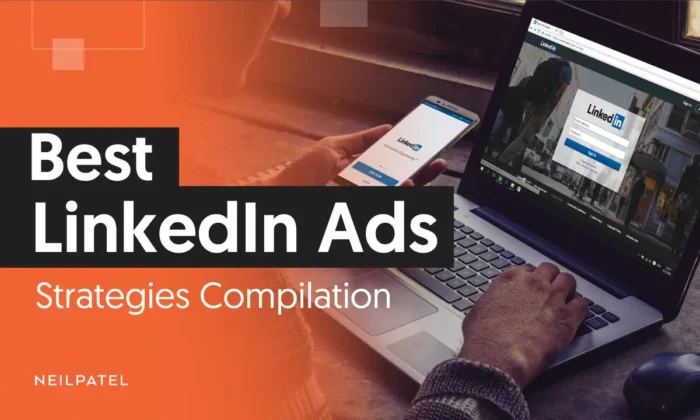
If you’re in the B2B space, there’s a good chance that your potential customers are on LinkedIn, making ads a promising investment.
Following LinkedIn ads best practices increases your chances of connecting with your target customer and getting leads.
In this post, I explore how to identify those customers, key metrics to be aware of, the different types of LinkedIn ads, and how to optimize copy and design for each.
Let’s get started with the fundamentals of any online marketing campaign.
Key Takeaways
- LinkedIn ads are more expensive than other social media ads because the platform enables precise targeting to a high-value audience.
- Marketers can choose from different ad types, from single-image ads to video content.
- Understanding your audience can help target which types will be most effective. LinkedIn gives marketers the ability to get granular with targeted by location, job title, type of company, and more.
- The platform also offers performance tracking tools that help marketers adjust content design and messaging to increase engagement and conversions.
- Effective ads combine strong copy, visuals, and a powerful CTA to motivate LinkedIn users to interact.
See How My Agency Can Drive More Traffic to Your Website
Why Advertise on LinkedIn?
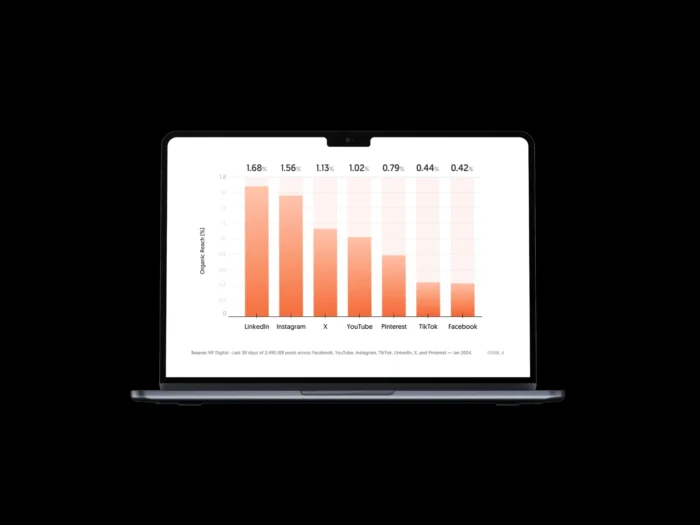
Real talk—social media reach is shrinking. Organic engagement is down, competition is up, and businesses are struggling to get in front of the right audience. But after analyzing 15,000 social media profiles we came to one conclusion: LinkedIn is the exception.
Yes, LinkedIn ads cost more. But they put you in front of the people who matter—when they’re in business mode.
Most social platforms let you target users based on broad demographics. LinkedIn takes targeting to another level. Using account-based marketing, you can pinpoint decision-makers by job title or role, company size, industry, and even specific skills.
That means your ads land directly in front of the people who matter—and who are eager to engage, because people go there to learn, connect, and do business. Unlike other platforms where your ads might show up next to cat memes and low-quality clickbait, your brand is showcased in a professional environment.
Plus, it offers a variety of unique ad formats, like Sponsored Content and Message Ads, advanced reporting, and seamless CRM integrations—features most other platforms can’t match.
Are You Using Google Ads?Try Our FREE Ads Grader!
Stop wasting money and unlock the hidden potential of your advertising.
- Discover the power of intentional advertising.
- Reach your ideal target audience.
- Maximize ad spend efficiency.
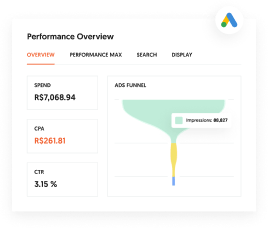
Get your free Analysis
Other reasons LinkedIn’s ad costs are higher than other platforms:
- Smaller, high-value audiences. You’re not blasting ads to random users, you’re targeting decision-makers.
- Frequency caps. Ensuring users don’t get bombarded with ads helps keep engagement high.
- Quality placements. LinkedIn provides prime real estate to maximize visibility.
“Think of LinkedIn as an investment, not an expense,” says Erik Stebbins, Associate Director of Paid Social at NP Digital. “With the right strategy, you’re paying for high-value conversions, not just cheap clicks.”
So it’s clear: the question isn’t whether you can afford LinkedIn ads—it’s whether you can afford to ignore them.
Start by Knowing Your Target Audience
LinkedIn doesn’t just give you data—it gives you insight. And insight powers precise targeting.
LinkedIn provides some of the most granular reporting of any platform, including in-depth audience analysis, ad engagement breakdown, to even website demographics. This is valuable information that leads to incredibly powerful targeting capabilities.
“LinkedIn’s targeting capabilities are unmatched,” says Stebbins. “From job titles and industries to company growth rates, you have an unparalleled ability to get your message in front of the right audience.”
However, there’s no point in having access to all of that targeting power if you don’t know how to identify your audience on the platform. Here’s how to do that.
Assessing Current Customers
Before you get started creating an ad, you need to spend some time thinking about who your ideal customer is. One of the most effective ways to do this is by creating a buyer persona.
You can use your current and past customers as a guide. This means looking at and analyzing specific factors to find commonalities or frequent characteristics among them, such as:
- Geographical location
- Industry
- Job role or title
- Company type or function
- Company size, financial, and growth rate
Note that you can have several buyer personas, enabling you to target different types of customers.
Identifying Key Traits
Once you have your buyer personas, you can start analyzing the LinkedIn profiles of members that align with them to identify characteristics they have in common.
Some key traits could include:
- Demographics (age, gender, level of education)
- Professional background and experience
- Interests
- Device usage
- Activity level on LinkedIn
These insights can add to your understanding of your potential customers and further enhance your ad targeting.
Segment Your Audience
Are you looking to make your marketing efforts more effective? Then segment your audience. Segmentation enables you to tailor content and ad campaigns according to the needs of particular customer groups.
With this approach, you can ensure that every message resonates with its intended recipient – dramatically increasing engagement rates and ROI.
For example, you could segment your customers by:
- Interests
- Demographics
- Past purchases
- Search data
However, you could also segment by psychographics and audience size.
Regular A/B testing among different segments—running similar campaigns with variations—can help you hone in on the needs of these groups.
Study Your Competition and See What’s Going for Them
By studying your competitors’ practices, you can determine which strategies are most effective and apply them accordingly.
Want to know what your competitors are running? Use LinkedIn’s Ad Library to peek behind the curtain.
LinkedIn Ads Library is a publicly accessible database of ads that have appeared on the platform. And it’s a handy tool as you create your own ad strategy.
Start by creating an extensive list of your competitors. To keep everything in order, create a spreadsheet.
Then go to LinkedIn Ads Library and look up each one. You can also search for ads by keyword.

Looking at your competitors’ ads will give you an idea of how to style your own marketing or help you identify fresh, original approaches.
You can also use tools like Semrush to track competitors’ ad strategies. Platforms like AdSpyder and BigSpy provide intelligence on competitors’ ads so you can monitor trends.
Social listening is another effective way to find out what your competitors are up to on LinkedIn. Services like Sprout Social and Brandwatch can help you track engagement on competitors’ ads.
Another potential tactic is to use LinkedIn Sales Navigator to see if competitors employ or have recently hired paid media specialists, which means they’re focusing on ads. This can help you identify specific competitors to investigate further.
Finally, you can figure out what competitors are doing by acting like one of their customers. Go to their LinkedIn pages, click “follow,” and then check out the ads that the platform serves up. You can even click on their ads and see if you get different ads as part of a retargeting strategy.
Follow Relevant Social Trends
Guessing what your audience cares about is a waste of time. Tap into trends they already care about. So, if you want to encourage engagement on your LinkedIn ads, start by paying attention to social trends.
By leveraging trends strategically, you can ride the wave of what’s already capturing attention. But don’t jump on just any trend. Focus on the ones relevant to your industry and audience. A well-timed ad that aligns with an industry shift, recent news, or a hot-button topic shows that your brand is up-to-date with what’s happening.
The key is to tie that to content that showcases your organization’s expertise, features, or value and is easily shareable. Think about data-driven insights, bold opinions, or statistics that spark discussion.
When done right, these ads don’t just boost visibility—they can drive significant revenue.
Not sure where to start? Use tools like Google Trends, AnswerThePublic, or Exploding Topics to spot popular trends. Then craft LinkedIn ads that connect your offer to what people are already searching for. The more organically you fit into the conversation, the higher your potential engagement—and the lower your ad costs.
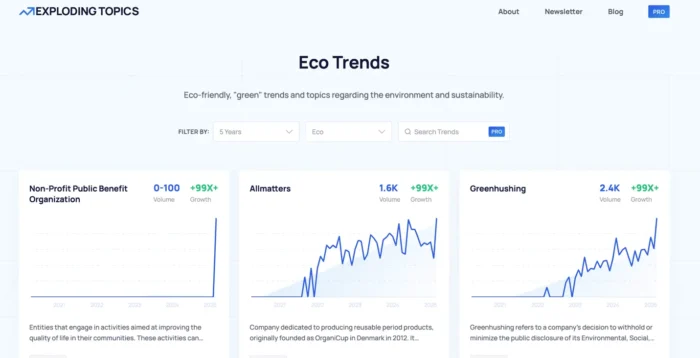
Establish Your KPIs
Given the expense of LinkedIn ads, you’ll want to make sure that you’re on the right track to conversions and leads.
Establishing Key Performance Indicators (KPIs) is an important step in measuring progress and determining where you can make improvements and adjustments. Whether you’re a small business owner or a corporate executive, having the right KPIs in place can make a world of difference in driving progress and achieving success.
Below are some KPIs you should look at as part of LinkedIn ads best practices.
Engagement Rates
Whether you’re running an online ad, engagement rates help you understand how effective your messaging is and determine if it’s resonating with your target audience.
High engagement rates demonstrate that your ads are hitting their mark and tailor future campaigns to maximize ROI.
The average engagement rate for a single-image ad is less than 2 percent, although this can vary for other types of ads as well as across industries.
You can see what resonates with users by testing different ad formats and analyzing what’s working. The better your engagement, the lower your cost per result—meaning more impact for your ad spend.
Page Views
These metrics measure the number of times your LinkedIn page has been viewed by users during a given time frame. While page views don’t measure ads, ads can drive more views of your organization’s LinkedIn page.
A great starting place to view your LinkedIn data is on your campaign manager page. However, tools like Hootsuite, Buffer, and Social Pilot can provide a detailed view of your LinkedIn analytics. These tools give you insights into what content is working and enable you to make informed decisions regarding future content.
Video Views
Video is another way to grab users’ attention. The dynamic format appeals to many different demographics and may be a better way to get across your message than static content to certain audience segments.
As a result, video views are an important metric for content creators and businesses alike. In the age of digital media, having a steady stream of video views can increase visibility on social media.
For a video view to count, a user must watch the video for a minimum of two continuous seconds, and the video is at least 50 percent on screen.
Post Views
Post views on LinkedIn mean someone has viewed your post in the home feed.
You can get a detailed look at your stats by going to your business’s LinkedIn page online.
However, post views don’t mean that a LinkedIn member has read your post, just that they’ve viewed it.
If your post views are on the low side, there’s plenty you can do to increase them.
Experiment with different topics and lengths for posts. Coming up with a strong hook or angle can also draw in views.
Don’t just post on your organization’s LinkedIn page. Encouraging the leadership team and other employees to post regularly can bring in more views and awareness of your brand.
Click-Through Rates
Click-through rates are a key indicator of success when it comes to web advertising. They measure the percentage of people who click on an advertisement or link out of all those that have seen it.
To ensure optimal results, track your click-through rates over time so you can quickly identify any changes in behavior from customers or trends in the market that may affect performance.
According to research, the global average click-through rate for sponsored LinkedIn content is 0.44 – 0.65 percent.
However, these vary depending on the type of ad. The B2BHouse.com LinkedIn Benchmarks show the following percentages:
- Sponsored content (single image): 0.56 percent
- Sponsored content (carousel): 0.40 percent
- Sponsored content (video): 0.44 percent
- Message ads: 3 percent with open rates at 30 percent
- Document ad: 0.43 percent
- Event Ad: 0.55 percent
These can be further broken down by industry, region, and seniority of the LinkedIn member, giving you even more insight into the effectiveness of your content.
Impressions and Reach
Impressions measure how many times users see content or a profile in their network feed. Impressions can be made on posts, stories, profiles, and advertisements. You chalk up an impression every time one of your ads appears in the home feed.
Reach measures how many individual users see content or a profile in their network feed; it’s the total of how many individual users get to see your ads in their home feed. Growing the reach of your page helps spread brand awareness and increase engagement from new potential customers.
Conversion Rates
Your conversion rate is the percentage of visitors to your LinkedIn ads who take action when they arrive there. It might be making a purchase, clicking to find out more information, or signing up for a newsletter.
Knowing and understanding your conversion rate helps you optimize your ads to drive increased engagement and enhance brand loyalty.
What should your conversion rates be on LinkedIn? Well, according to the B2BHouse benchmarks I linked to earlier, 5-15 percent is standard.
A lot of that variation is due to the way different companies define conversion. It could be filling out a form or clicking a button.
To track your conversion rates and measure your ROI, you can go to LinkedIn’s campaign manager.
You can also view your impressions, clicks, leads, and other core data here.
Cost Per Click
Cost per click (CPC )can provide insights into how much money you are spending to acquire new customers, and if it’s not within your projected budget, you can look at making adjustments.
To calculate CPC, divide the total cost of your campaign by the number of conversions that you achieved. For instance, if you spent $500 on a campaign and generated 10 conversions, each conversion would have cost $50.
But keep in mind that even a good CPC doesn’t mean much if you’re not getting high-quality leads.
There’s a calculator available if you need to work out your CPC.
Match the Content Type to the Ad Type
You’ve got the targeting dialed in—now make sure the message hits.
The success of LinkedIn ads isn’t just about who you target—it’s about how you target them. Each ad type demands a specific content strategy that speaks directly to the problems and preferences of your audience.
For sponsored content, think bold storytelling with a strong hook that stops the scroll. Image ads need eye-catching visuals and headlines that communicate your value proposition in a split second. For video ads, motion graphics must deliver insights in 30 seconds or less.
Text ads require razor-sharp copywriting—every word must count. Dynamic ads personalize the experience, so craft messaging that feels like a conversation.
Always align your content with your ultimate conversion goal.
Now let’s take a closer look at the main advert types.
Sponsored Content Ads
Sponsored content allows you to ”reach a highly engaged audience in the LinkedIn news feed.”
Sponsored content ads are a great form of social advertising, especially if you want your content marketing efforts to go to the right people.
Types of sponsored content ads can be broken into:
- Single image ads: These ads include one image and are a simple, effective way of reaching your target audience.

- Carousel ads: These ads feature a swipeable series of cards. You can showcase multiple offers/products to provide value and insight to your audience.
- Video ads: These can be published as sponsored content or through your campaign manager on LinkedIn.
However, it’s vital that you follow LinkedIn ad best practices when using any Sponsored ad campaign. In fact, I’d describe it as a golden rule. You see, to be successful, you must have at least one “conversion goal” (or a measurable CTA) in place – no matter how big or small.
This helps you calculate how to collect leads once someone engages with your content to make the most of your investment.
Text Ads
LinkedIn text ads feature at the right-hand side or at the top of the feed and are effective in helping you build solid leads with industry leaders.
They are easy to design, and aside from targeting, you only have to focus on copy and images.
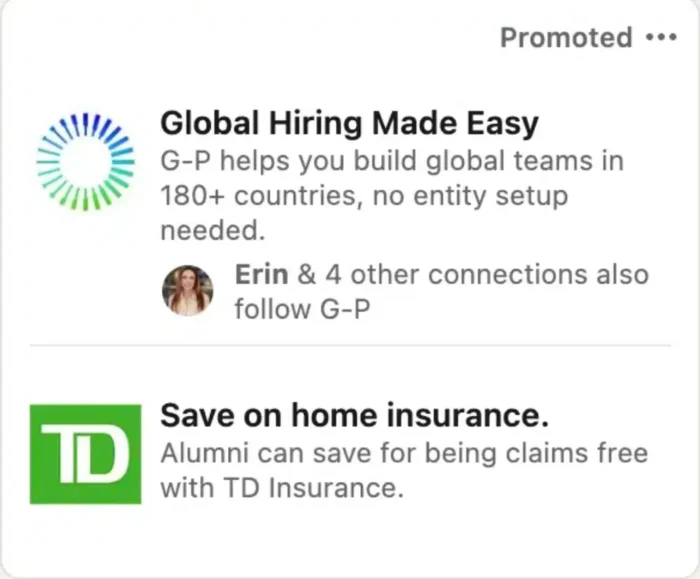
Thankfully, it’s pretty easy to test multiple variations of this ad, and you can rely on A/B testing to help you come up with a winning ad (more on that later).
When set up properly, text ads can deliver great results. However, they are expensive to run.
As an advertising platform, LinkedIn can price its ads higher than standard social media sites because they’re dealing primarily with a B2B market that can afford to pay the higher costs. Additionally, LinkedIn doesn’t have the inventory you’d find on social networks like Facebook and Google.
If you want to take the leap and create a text ad, you need to ensure you’ll get a return on investment. LinkedIn offers a few best practices, including:
- Include an image to make your ad stand out
- Address your audience directly
- Create a few ad variations for each campaign
Video Ads
According to Stebbins, “LinkedIn’s emphasis on video is no coincidence. Users engage with video content five times more than static posts—brands that aren’t leveraging this are missing a major opportunity.”
The numbers don’t lie: Video content on LinkedIn is dramatically outperforming other ad formats, with users engaging three times longer with video compared to other content types.
Short-form videos are particularly powerful, generating 32.18 percent more reach. Interestingly, the ideal video length has evolved—while short-form videos averaged just 13 seconds in 2020, they’re now up to 44 seconds. Perhaps our attention spans aren’t so short after all?
For marketers, this points to the need to create concise, compelling video narratives that can get your message across quickly and compellingly.
Create Ad Copy That Leads to Action (With CTAs)
Strong and engaging ad copy is essential to boost your brand’s visibility, attract potential customers, and drive more conversions.
LinkedIn ad best practices for crafting copy include:
- Keep it simple and relevant: focus on how your product or services can benefit your audience.
- Highlight any unique selling points or advantages that you may have over competitors.
- Make sure your headline stands out, while also highlighting what makes it different from other ads.
Also, guidelines in LinkedIn ad best practices for sponsored content say to:
- Keep headlines below 150 characters
- Limit descriptive copy to 70 characters or less
- Include up to five ads per campaign
Your call-to-action (CTA) is the critical point between engagement and conversion. On LinkedIn, your CTA must be clear and compelling enough to stop users from scrolling and get them to act.
LinkedIn offers guidance for CTAs, but your language will vary based on the nature of the ad and the offering. While many CTAs use metaphorical language like “unlock,” “discover,” or “accelerate,” In general, the most effective CTAs use action-oriented, urgent language that indicates a specific action, such as downloading a guide or registering for an event.
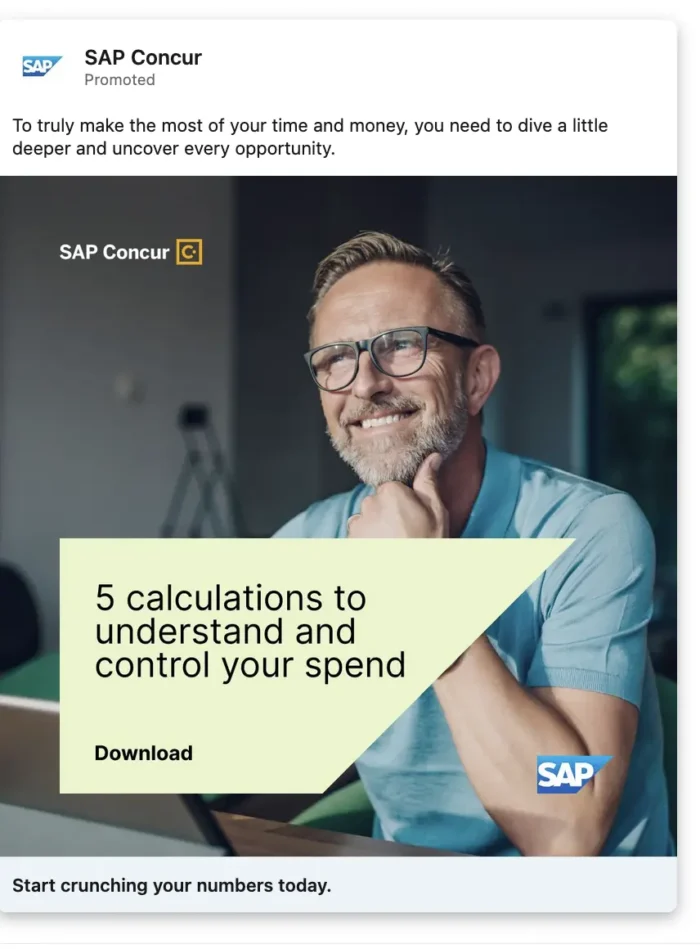
Even simple CTAs like ‘Learn more’ can convert—if the ad copy builds enough value. beforehand.

Create Eye-Popping Visuals and Images
Strong visuals make the difference between being scrolled past or getting that crucial click. Creating attention-getting visuals isn’t just about design—it’s about strategic communication that captures professional attention instantly.

Here are a few tips for creating eye-popping visuals for your LinkedIn ads.
- Keep it simple! Choose one color palette or image style that will be used throughout all of your ads. This helps with brand recognition and makes sure the visuals have a consistent look and feel.
- Use high-quality images that capture attention right away. Think about what type of image would draw potential customers – something colorful, vibrant, or even edgy.
- Inject some humor. Make your visuals funny, and you may be more likely to get a click-through.
- Use images that motivate and inspire, or add credibility with stats and testimonials about your brand.
- Follow LinkedIn ad best practices for images and include images measuring 1200 x 627 pixels.
- LinkedIn also advises you to embed larger images instead of using thumbnails.
Remember, every design element should motivate your target audience to take action.
Track Your Results and Make Adjustments
As with any ad, you’ll struggle to get people to buy from you right away, especially if they are unfamiliar with your brand.
In fact, marketing experts estimate audiences need to see something 7 times before they act.
Don’t expect instant sales—especially from cold audiences. But every click is data you can use to optimize each and every lead.
How?
By using LinkedIn’s Conversions API (CAPI).
This tool is a game-changer. By creating a secure connection between first-party marketing data and the LinkedIn platform, it enables you to see a comprehensive view of ad performance.
You can see online actions like clicks and downloads across different devices and browsers, and even offline activities, such as phone sales.
This lets you gather data to help you adjust ad content, format, frequency, and other factors to increase conversions and maximize your ROI.
Focus on creative in particular, says Stebbins: “Creative is the biggest lever you can pull to drive performance. If you’re not consistently testing and optimizing your creative, you’re leaving money on the table.”
CAPI also increases privacy for both LinkedIn members and advertisers by doing away with the need for cookie-based tracking and enabling you to decide what types of data you want to share with the platform, how, and when.
The benefits of using CAPI are pretty stunning: a 31 percent increase in attributed conversions and a 20 percent decrease in cost-per-action.
Optimizing your ad campaigns over the long term will help you continually achieve better and better results as your brand exposure increases.
- Try different forms of copy and images on your ad to see what works best and gains the most attention.
- Change your CTA and landing pages. This will give you insight into what your audience responds to best and where the best conversion rates come from.
- Experiment with calling people who sign up to see if you can convert them into a customer on a call, as opposed to using an autoresponder to convert them.
- Introduce a webinar or PDF as a lead magnet that educates your customers about what you do and how you can help them.
FAQs
What type of LinkedIn ads perform best?
There are a lot of factors that go into ad performance on LinkedIn, making it difficult to say which ones are the best. But trends do indicate that certain types perform better than others.
Video ads tend to outperform other formats, with 88 percent of marketers reporting an improvement in ROI. Short-form videos especially show high performance.
Sponsored Content is another top performer on LinkedIn. These native ads seamlessly integrate into the feed, delivering higher engagement rates compared to traditional display advertising.
First, you need to know your target audience well enough so that you can identify which format aligns with their preferences and craft a message that resonates with them. You should also make sure your ad contains visuals that appeal to their interests and needs. Additionally, it’s important to include a clear call-to-action and link it back to your website or landing page where they can convert. Finally, you need to set up tracking mechanisms so you can measure the success of the ads and modify them as needed.
What should a LinkedIn ad include?
A well-crafted LinkedIn ad should feature a clear message that presents your company’s unique value proposition.
Crafting an attention-grabbing headline can draw people in and entice them to click through and learn more about your product or service. Additionally, you may want to include visuals such as images or videos that will make the ad stand out from other content. The design should effectively bring copy and visuals together, increasing the power of the message.
Finally, it’s essential that you provide a strong call to action so that users know what to do next.
What are the best days to run LinkedIn ads?
According to research, the best times to post are between 8 and 9 AM on Tuesdays and Wednesdays, so it makes sense that these would also be the best times to run ads.
Other top times during the week are (all times PST):
- Monday, 11 AM
- Tuesday, 6-8 AM
- Wednesday, 9 AM
- Thursday, 2 PM
- Friday, 8 PM
Weekends are typically the worst times to post ads on LinkedIn. However, there are many variables that can affect optimal posting times, including what industry you’re in.
Conclusion
LinkedIn is where serious marketers come to play. Advertising there is different from doing it on other social media channels—it’s a platform where you can connect with high-value professional audiences who are there to learn.
From granular targeting to innovative ad formats, it offers unparalleled opportunities for businesses looking to make a significant impact and get the word out about their products and services.
Success comes down to understanding your audience, creating compelling content, and continuously optimizing your approach. Using tools like Ubersuggest can help you zero in on content types and topics that will resonate with your audience.
But you also need to track performance and adjust ad formats, content, and visuals consistently to ensure you’re getting the most bang for your advertising buck.
By implementing the strategies I’ve discussed—from precise targeting to eye-catching visuals and data-driven tracking—you can transform your advertising efforts into a powerful tool for business growth.






